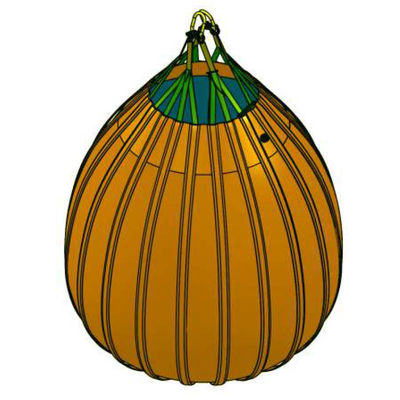Boat Air Bags Diving Underwater Inflatable Parachute Professional Scuba Lift Bag
Description
In the world of marine salvage and recovery, the use of Boat Air Bags has transformed the way operators approach underwater lifting challenges. These inflatable lift bags are designed to provide substantial lifting power, allowing marine specialists to raise sunken boats, heavy equipment, and other submerged objects with ease. Built from robust materials that resist tearing and puncturing, Boat Air Bags can handle the rigors of deep-sea conditions. Their buoyancy control capabilities allow operators to adjust the lift force precisely, ensuring safe and effective lifting. Boat Air Bags are not only a practical solution but also a cost-effective one, reducing the need for extensive equipment and extensive manpower in salvage operations. As a vital component of modern maritime technology, these air bags continue to enhance the efficiency of underwater recoveries.

Specifications
| Product Name |
Boat Air Bags |
| Raw Material |
Top Notch PVC Coating Fabric |
| Type |
Parachute |
| Size |
500kg, 1000kg, 5000kg 10000kg,etc |
| Thickness |
0.4-1.2mm, or as request |
| Color |
Yellow, Blue, Black, etc |
| Density |
0.33-0.9g/cm3 |
| Safety Factor |
7:1 |
| Accessories |
Valve, Inflatable Tube, Repair Material |
| OEM |
Welcome |
| Warranty |
3 Years |
|
Tolerances
|
+/- 0.03 on densities
+/- 0.2 mm on thickness
+/- 0 to +3mm on width
+/- 0 to +3mm on length
|
| Model |
Lifting Capacity |
Dimensions |
Appr. Weight |
| Parachute |
[kg] |
[lbs] |
[mm] |
[kg] |
| HM-P01 |
200 |
441 |
800 |
5 |
| HM-P02 |
500 |
1,103 |
1,000 |
8 |
| HM-P03 |
1,000 |
2,205 |
1,300 |
11 |
| HM-P04 |
2,000 |
4,410 |
1,600 |
20 |
| HM-P05 |
4,000 |
8,820 |
2,000 |
50 |
| HM-P06 |
6,000 |
13,230 |
2,300 |
66 |
| HM-P07 |
8,000 |
17,640 |
2,500 |
75 |
| HM-P08 |
10,000 |
22,050 |
2,700 |
80 |
| HM-P09 |
15,000 |
33,075 |
3,100 |
110 |
| HM-P10 |
20,000 |
44,100 |
3,400 |
130 |
| HM-P11 |
30,000 |
66,150 |
3,900 |
170 |
| HM-P12 |
50,000 |
110,250 |
4,600 |
220 |
| HM-P13 |
70,000 |
154,350 |
5,200 |
310 |
| HM-P14 |
100,000 |
220,500 |
5,800 |
450 |
| HM-P15 |
150,000 |
330,750 |
6,600 |
660 |
| HM-P16 |
200,000 |
441,000 |
7,300 |
900 |
| *Note: Other sizes can be customized according to the requirements. |
Features
Versatile Sizes
Available in various sizes to accommodate different lifting capacities, ensuring suitability for a wide range of tasks.
Adjustable Buoyancy
Equipped with features that allow operators to fine-tune buoyancy levels, providing enhanced control during lifting operations.
Compact Design
Lightweight and collapsible when deflated, making air bags easy to transport and store without requiring much space.
Multi Functional Use
Suitable for various applications, including salvage operations, construction, inspections, and emergency responses.
Applications
● Underwater Inspection and Maintenance
● Pipe and Cable Lifting
● Construction Site Support
● Environmental Cleanup Efforts
Advantages
Custom Manufacturing
Ability to produce tailor-made air bags to meet specific customer requirements and unique applications.
Robust Material Selection
Sourcing high-quality materials that enhance durability, resistance, and overall performance of air bags.
Research and Development
Continuous investment in RD to innovate and improve product designs and functionalities.
Strong Customer Relationships
Establishing long term relationships with clients, focusing on understanding their needs and providing excellent service.


FAQ
1. Can Boat Air Bags be used for underwater operations?
Yes, Boat Air Bags can be used for underwater operations, such as lifting sunken boats or ships. The material is designed to withstand submersion in water and maintain its strength.
2. What is the maximum lifting capacity of a Boat Air Bag?
The lifting capacity varies depending on the model, but Boat Air Bags can typically lift vessels ranging from a few tons to several hundred tons. It's important to select an air bag with an appropriate capacity for the job.
3. How do you maintain Boat Air Bags?
Maintenance involves regular inspection for punctures or wear, cleaning after use (especially in saltwater environments), and proper storage in a cool, dry place. Check the inflation valves and ensure they are functioning properly.
4. Can Boat Air Bags be used for long-distance transportation of boats?
Yes, Boat Air Bags can be used to transport boats over short or long distances, particularly when a boat needs to be lifted over obstacles like rocks, sandbars, or low bridges.

 Your message must be between 20-3,000 characters!
Your message must be between 20-3,000 characters! Please check your E-mail!
Please check your E-mail!  Your message must be between 20-3,000 characters!
Your message must be between 20-3,000 characters! Please check your E-mail!
Please check your E-mail! 














